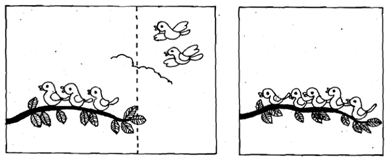Ms. Mehta teaches in a government primary school in Delhi. The children who come to her in Class 1 are familiar with a few numbers. At the beginning of the session, she asks the children to collect objects, say pebbles, and count how many there are.
She also asks them to join two sets of them to find the total. She does this with various kinds of objects that the children can easily find around them. Then she gives them opportunities to practise addition without their being aware of it through games like the following: ,
Let two children or two teams take dice and stones. Each child (or team) throws the dice and picks up as many stones as the number on the dice. Whoever gets more in two turn's added together wins?
Throughout these activities she asks any one team member to loudly speak out what the team is doing.
There are many other kinds of activities that she also uses. For instance, she shows the children pictorial cards like the one in Fig. 1, in stages -first showing only the three sitting birds, then the two flying in. Then she asks them to find out the total number of birds in it.

After they have come out with the answer, she uncovers the right hand side of the picture.
They do this kind of exercise with several cards. She also adds the following kind of portion to each card, in stages, uncovering it and reading it out aloud line by line.
3 and 2 more makes 5.
3 and 2 is 5.
3 plus 2 is equal to 5.
3 +<2 = 5. I
Gradually, with a lot of exposure of this kind, she finds that they start associating the words' pluses and 'equal to' with their symbols. At this stage she gives them pictorial worksheet@ like the ones, and asks them to write down the addition that they see in a picture below it.